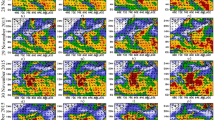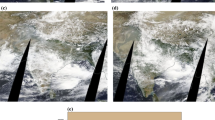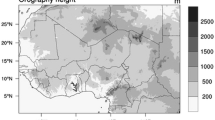Abstract
Data assimilation is considered as one of the effective tools for improving forecast skill of mesoscale models. However, for optimum utilization and effective assimilation of observations, many factors need to be taken into account while designing data assimilation methodology. One of the critical components that determines the amount and propagation observation information into the analysis, is model background error statistics (BES). The objective of this study is to quantify how BES in data assimilation impacts on simulation of heavy rainfall events over a southern state in India, Karnataka. Simulations of 40 heavy rainfall events were carried out using Weather Research and Forecasting Model with and without data assimilation. The assimilation experiments were conducted using global and regional BES while the experiment with no assimilation was used as the baseline for assessing the impact of data assimilation. The simulated rainfall is verified against high-resolution rain-gage observations over Karnataka. Statistical evaluation using several accuracy and skill measures shows that data assimilation has improved the heavy rainfall simulation. Our results showed that the experiment using regional BES outperformed the one which used global BES. Critical thermo-dynamic variables conducive for heavy rainfall like convective available potential energy simulated using regional BES is more realistic compared to global BES. It is pointed out that these results have important practical implications in design of forecast platforms while decision-making during extreme weather events









Similar content being viewed by others
References
Alexandre, O., et al. (2015). Impact of storm-scale lightning data assimilation on wrf-arw precipitation forecasts during the 2013 warm season over the contiguous united states. Monthly Weather Review, 143, 757–777. doi:10.1175/MWR-D-14-00183.1.
Amengual, A., et al. (2007). A hydro meteorological modeling study of a flash-flood event over Catalonia, Spain. Journal of Hydrometeorology, 8, 282–303.
Anil Kumar, Dudhia, J., Rotunno, R., Niyogi, D., & Mohanty, U. C. (2008). Analysis of the 26 July 2005 heavy rain event over Mumbai, India using the Weather Research and Forecasting (WRF) model. Quarterly Journal Royal Meteorological Society, 134, 1897–1910.
Argence, S., et al. (2008). Impact of initial conditions uncertainties on the predictability of heavy rainfall in the Mediterranean: A case study. Quarterly Journal of the Royal Meteorological Society, 134, 1775–1788.
Bannister, R. N. (2008). A review of forecast error covariance statistics in atmospheric variational data assimilation. II: Modelling the forecast error covariance statistics. Quarterly Journal Royal Meteorological Society, 134, 1971–1996.
Barker, D. M., Huang, W., Guo, Y-R., Bourgeois, A. J., & Xiao, Q. N. (2004). A Three-Dimensional Variational Data Assimilation System for MM5: Implementation and Initial Results. Monthly Weather Review, 132(4), 897–914.
Bei, N., & Zhang, F. (2007). Impacts of initial condition errors on mesoscale predictability of heavy precipitation along the Mei-Yu front of China. Quarterly Journal of the Royal Meteorological Society, 133, 83–99.
Berre, L., Ecaterin, S. S., & Pereira, M. B. (2006). The representation of the analysis effect in three error simulation techniques. Tellus A, 58, 196–209.
Bhaskar Rao DV, Hari Prasad D, Srinivas D (2009) Impact of horizontal resolution and the advantages of the nested domains approach in the prediction of tropical cyclone intensification and movement. Journal of Geophysical Research, 114. doi:10.1029/2008JD011623.
Boilley, A., & Mahfouf, J. F. (2012). Assimilation of low-level wind in a high-resolution mesoscale model using the back and forth nudging algorithm. Tellus A, 64, 18697. doi:10.3402/tellusa.v64i0.18697.
Boloni, G., Berreb, L., & Adamcseka, E. (2015). Comparison of static mesoscale background-error covariances estimated by three different ensemble data assimilation techniques. Quarterly Journal Royal Meteorological Society, 141, 413–425.
Brennan, M. J., Hennon, C. C., & Knabb, R. D. (2009). The operational use of QSCAT ocean surface vector winds at the National Hurricane Center. Weather and Forecasting, 24, 621–645.
Cassola, F., Ferrarib, F., & Mazzinob, A. (2015). Numerical simulations of Mediterranean heavy precipitation events with the WRF model: A verification exercise using different approaches. Atmospheric Research, 164–165, 210–225.
Chen, C. S., et al. (2013). Orographic effects on heavy rainfall events over northeastern Taiwan during the northeasterly monsoon season. Atmospheric Research, 122, 310–335.
Counillon, F., et al. (2014). Seasonal-to-decadal predictions with the ensemble Kalman filter and the Norwegian Earth System Model: A twin experiment. Tellus A, 66, 21074. doi:10.3402/tellusa.v66.21074.
Daget, N., Weaver, A. T., & Balmaseda, M. A. (2009). Ensemble estimation of background-error variances in a three-dimensional variational data assimilation system for the global ocean. Quarterly Journal Royal Meteorological Society, 135, 1071–1094.
Das, S., et al. (2008). Skills of different mesoscale models over Indian region during monsoon season: Forecast errors. Journal of Earth System Science, 117(5), 603–620.
Deb, S. K., Kishtawal, C. M., Pal, P. K., & Joshi, P. C. (2008). Impact of TMI SST on the simulation of a heavy rainfall episode over Mumbai on 26 July 2005. Monthly Weather Review, 136(10), 3714–3741
Dobricic, S., et al. (2015). Assimilation of oceanographic observations with estimates of vertical background-error covariances by a Bayesian hierarchical model. Quarterly Journal Royal Meteorological Society, 141, 182–194. doi:10.1002/qj.2348.
Dudhia, J. (1989). Numerical study of convection observed during the Winter Monsoon Experiment using a mesoscale two-dimensional model. Journal of the Atmospheric Sciences, 46(20), 3077–3107. doi:10.1175/1520-0469.
Fan, X., Krieger, J. R., Zhang, J., & Zhang, X. (2013). Assimilating QuikSCAT ocean surface winds with the Weather Research and Forecasting model for surface wind-filed simulation over the Chukchi/Beaufort Seas. Boundary-Layer Meteorology, 148(1), 207–226.
Fisher, M. (2003). Background error covariance modeling. Proceedings of Seminar on Recent developments in data assimilation for atmosphere and ocean, Reading, United Kingdom, ECMWF, pp. 45–63.
Giorgi, F., & Marinucci, M. R. (1996). An investigation of the sensitivity of simulated precipitation to model resolution and its implications for climate studies. Monthly Weather Review, 124, 148–166.
Goswami, P., Rakesh, V., Patra, G. K., & Prakash, V. S. (2012). Real-time quantitative rainfall forecasts at hobli-level over Karnataka: Evaluation for the winter monsoon 2010. Current Science, 102(10), 1426–1433.
Guo, Y. R., et al. (2005). Impact of ground-based GPS PW and MM5-3DVar background error statistics on forecast of a convective case. SOLA, 1, 73–76.
Holley, D. M., Dorling, S. R., Steele, C. J. and Earl, N. (2014). A climatology of convective available potential energy in Great Britain. International Journal of Climatology, 34, 3811–3824. doi:10.1002/joc.3976.
Hong, S. Y., & Lim, J. O. J. (2006). The WRF single-moment 6-class microphysics scheme (WSM6). Journal of the Korean Meteorological Society, 42(2), 129–151.
Hong, S. Y., Noh, Y., & Dudhia, J. (2006). A new vertical diffusion package with an explicit treatment of entrainment processes. Monthly Weather Review, 134, 2318–2341. doi:10.1175/MWR3199.1.
Horanyi, A., Cardinali, C., Rennie, M., & Isaksen, L. (2015). The assimilation of horizontal line-of-sight wind information into the ECMWF data assimilation and forecasting system. Part I: The assessment of wind impact. Quarterly Journal of the Royal Meteorological Society, 141, 1223–1232. doi:10.1002/qj.2430.
Janowiak, J. E., et al. (2010). An evaluation of precipitation forecasts from operational models and reanalyses including precipitation variations associated with MJO activity. Monthly Weather Review, 138, 4542–4560.
Kain, J. S. (2004). The Kain-Fritsch convective parameterization: An update. Journal of Applied Meteorology and Climatology, 43, 170–181. doi:10.1175/1520-0450(2004)043.
Kalnay, E. (2003). Atmospheric modeling, data assimilation and predictability (p. 341). Cambridge, USA: Cambridge University Press.
Krishnamurti, T. N., Mishra, A. K., Chakraborty, A., & Rajeevan, M. (2009). Improving global model precipitation forecasts over India using downscaling and the FSU superensemble. Part I: 1–5-Day forecasts. Monthly Weather Review, 137, 2713–2735.
Kuznetsov, L., Ide, K., & Jones, C. K. R. T. (2003). A method for assimilation of Lagrangian data. Monthly Weather Review, 131, 2247–2260.
Lakshmivarahan, S., Lewis, J. M., & Phan, D. (2013). Data assimilation as a problem in optimal tracking: Application of Pontryagin’s minimum principle to atmospheric science. Journal of the Atmospheric Sciences, 70, 1257–1277.
Le Duc, K. S., & Hiromu, S. (2013). Spatial-temporal fractions verification for high-resolution ensemble forecasts. Tellus A, 65, 18171. doi:10.3402/tellusa.v65i0.18171.
Lepore, C. D. V., & Annalisa, M. (2015). Temperature and CAPE dependence of rainfall extremes in the eastern United States. Geophysical Research Letters, 42(1), 74–83.
Lindskog, M., Gustafsson, N., & Mogensen, K. S. (2006). Representation of background error standard deviations in a limited area model data assimilation system. Tellus A, 58, 430–444.
Michel, Y., & Auligne, T. (2010). Inhomogeneous background error modeling and estimation over Antarctica. Monthly Weather Review, 138, 2229–2252.
Mlawer, E. J., Taubman, S. J., Brown, P. D., Iacono, M. J., & Clough, S. A. (1997). Radiative transfer for inhomogeneous atmospheres: RRTM, a validated correlated-k model for the long-wave. Journal Geophysical Research, 102(D14), 16663–16682. doi:10.1029/97JD00237.
Mohapatra, M., & Mohanty, U. C. (2005). Some characteristics of very heavy rainfall over Orissa during summer monsoon season. Journal of Earth System Science, 114(1), 17–36.
Moufouma-Okia, W., & Rowell, D. P. (2009). Impact of soil moisture initialization and lateral boundary conditions on regional climate simulations of the West African Monsoon Climate Dynamics. Climate Dynamics, 35(1), 213–229.
Park, J. H., Oh, S. G., & Suh, M. S. (2013). Impacts of boundary conditions on the precipitation simulation of RegCM4 in the CORDEX East Asia domain. Journal of Geophysical Research: Atmospheres, 118, 1652–1667. doi:10.1002/jgrd.50159.
Parrish, D. F., & Derber, J. C. (1992). The National Meteorological Center’s spectral statistical interpolation analysis system. Monthly Weather Review, 120, 1747–1763.
Pennelly, C., Reuter, G., & Flesch, T. (2014). Verification of the WRF model for simulating heavy precipitation in Alberta. Atmospheric Research, 135–136, 172–192.
Pereira, M. B., & Berre, L. (2006). The use of an ensemble approach to study the background error covariances in a global NWP Model. Monthly Weather Review, 134, 2466–2489.
Rabier, F. (2005). Overview of global data assimilation developments in numerical weather-prediction centers. Quarterly Journal of the Royal Meteorological Society, 131, 3215–3233.
Rakesh, V., & Goswami, P. (2011a). Impact of background error statistics on 3D-Var assimilation: Case study over the Indian region. Meteorology and Atmospheric Physics, 112, 63–79.
Rakesh, V., & Goswami, P. (2011b). Impact of background error statistics on forecasting of tropical cyclones over the north Indian Ocean. Journal of Geophysical Research: Atmospheres, 116, D20130. doi:10.1029/2011JD015751.
Rakesh, V., & Goswami, P. (2015). Impact of data assimilation on high-resolution rainfall forecasts: A spatial, seasonal and category analysis. Journal of Geophysical Research: Atmospheres, 120, 359–377. doi:10.1002/2014JD022383.
Rakesh, V., Goswami, P., & Prakash, V. S. (2015). Evaluation of high resolution rainfall forecasts over Karnataka for southwest and northeast Monsoon Seasons 2011. Meteorological Applications (Journal of Royal Meteorological Society, UK), 22, 37–47.
Rakesh, V., Singh, R., Pal, P. K., & Joshi, P.C. (2007). Sensitivity of mesoscale model forecast during a satellite launch to different cumulus parameterization schemes in MM5. Pure and Applied Geophysics (PAGEOPH), 164(8–9), 1617–1637.
Rakesh, V., Singh, R., Pal, P. K., & Joshi, P. C. (2009a). Impact of satellite observed surface wind and total precipitable water on WRF short-range forecasts over Indian region during monsoon 2006. Weather and Forecasting, 24, 1706–1731.
Rakesh, V., Singh, R., Yuliya, D., Pal, P. K., & Joshi, P. C. (2009b). Impact of variational assimilation of MODIS thermodynamic profiles in the simulation of western disturbance. International Journal of Remote Sensing, 30(18), 4867–4887.
Rakesh, V., Singh, R., Pal, P. K., & Joshi, P. C. (2010). Impact of four dimensional assimilation of satellite data on long-range simulations over the Indian region during monsoon 2006. Advances in Space Research, 46, 895–908.
Rakesh, V., Singh, R., & Joshi, P. C. (2011a). Impact of satellite soundings on the simulation of heavy rainfall associated with tropical depressions. Natural Hazards, 58, 945–980. doi:10.1007/s11069-010-9700-9.
Rakesh, V., Singh, R., & Joshi, P. C. (2011b). Evaluation of short-range forecasts from a meso-scale model over the Indian region during monsoon 2006. Pure and Applied Geophysics, 168, 919–943.
Routray, A., et al. (2014). Simulation of monsoon depressions using WRF-VAR: Impact of different background error statistics and lateral boundary conditions. Monthly Weather Review, 142, 3586–3613. doi:10.1175/MWR-D-13-00285.1.
Sahu, K. D., Dash, S. K., & Bhan, S. C. (2014). Impact of surface observations on simulation of rainfall over NCR Delhi using regional background error statistics in WRF-3DVAR model. Meteorology and Atmospheric Physics, 125(1), 17–42.
Sandeep, S., Chandrasekar, A., & Singh, D. (2006). The impact of assimilation of AMSU data for the prediction of a tropical cyclone over India using a mesoscale model. International Journal of Remote Sensing, 27, 4621–4653.
Singh, R., Ojha, S. P., Kishtawal, C. M., & Pal, P. K. (2014). Impact of various observing systems on weather analysis and forecast over the Indian region. Journal of Geophysical Research: Atmospheres, 119(10), 10,232–10246. doi:10.1002/2014JD021890.
Siroka, M., et al. (2003). The definition of mesoscale selective forecast error covariances for a limited area variational analysis. Meteorology and Atmospheric Physics, 82, 227–244.
Skamarock, W. C., et al. (2005). A description of the Advanced Research WRF, Version 2. NCAR Tech. Note., NCAR/TN-468 + STR [Available from UCAR Communications, P.O. Box 3000, Boulder, CO 80307].
Stratman, D. R., et al. (2013). Use of multiple verification methods to evaluate forecasts of convection from hot- and cold-start convection-allowing models. Weather and Forecasting, 28, 119–138. doi:10.1175/WAF-D-12-00022.1.
Szunyogh, I., et al. (2008). A local ensemble transform Kalman filter data assimilation system for the NCEP global model. Tellus A, 60(1), 113–130.
Tewari, M., Chen, F., Wang, W., Dudhia, J., LeMone, M. A., Mitchell, K., et al. (2004). Implementation and verification of the unified NOAH land surface model in the WRF model. In 20th Conference on Weather Analysis and Forecasting, 16th Conference on Numerical Weather Prediction, Amer. Meteorol. Soc., Seattle, Wash.
Tokay, A., & Short, D. A. (1996). Evidence from tropical raindrop spectra of the origin of rain from stratiform versus covective clouds. Journal of applied meteorology, 35, 355–371.
Vinodkumar, Chandrasekar, A., Alapaty, K., Niyogi, D. (2008). The impacts of indirect soil moisture assimilation and direct surface temperature and humidity assimilation on a mesoscale model simulation of an Indian Monsoon depression. Journal of Applied Meteorology and Climatology, 47, 1393–1412.
Wang, X., Parrish, D. F., Kleist, T. D., & Whitaker, J. (2013). GSI 3DVar-based ensemble–variational hybrid data assimilation for NCEP Global Forecast System: Single-resolution experiments. Monthly Weather Review, 141, 4098–4117. doi:10.1175/MWR-D-12-00141.1.
Wang, W., & Seaman, N. L. (1997). A comparison study of convective parameterization schemes in a mesoscale model. Monthly Weather Review, 125, 252–278.
Wang, B., Zou, X., & Zhu, J. (2000). Data assimilation and its applications. PNAS, 97(21). doi:10.1073/pnas.97.21.11143.
Wang, H., et al. (2014). Inhomogeneous background error modeling for WRF-Var using the NMC method. Journal of Applied Meteorology and Climatology, 53, 2287–2309. doi:10.1175/JAMC-D-13-0281.1.
Wilks, D. S. (2006). Statistical methods in the atmospheric sciences. International Geophysics Series (2nd ed., Vol. 91, p. 627). California, USA: Academic Press.
Wu, W. S., Purser, R. J., & Parrish, D. F. (2002). Three-dimensional variational approach analysis with spatially inhomogeneous covariances. Monthly Weather Review, 130, 2905–2916.
Yang, M. J., & Tung, Q. C. (2003). Evaluation of rainfall forecasts over Taiwan by four cumulus parameterization schemes. Journal of the Meteorological Society of Japan, 81, 1163–1183.
Yao, C., et al. (2008). Regional summer precipitation events in Asia and their changes in the past decades. Journal Geophysical Research, 113, D17107. doi:10.1029/2007JD009603.
Yesubabu, V., Srinivas, C. V., Langodan, S., & Hoteit, I. (2016). Predicting extreme rainfall events over Jeddah, Saudi Arabia: Impact of data assimilation with conventional and satellite observations. Quarterly Journal of the Royal Meteorological Society, 142, 327–348. doi:10.1002/qj.2654.
Yesubabu, V., et al. (2014). Impact of variational assimilation technique on simulation of a heavy rainfall event over Pune, India. Natural Hazards, 71(1), 639–658.
Zapotocny, T. H., et al. (2007). A two season impact study of satellite and In Situ data in the NCEP Global Data Assimilation system. Weather and Forecasting, 22, 887–909.
Zeng, X. M., et al. (2012). Effects of different land-surface schemes on the simulation of a heavy rainfall event by WRF. Chinese Journal of Geophysics, 55, 394–408. doi:10.1002/cjg2.1734.
Zhang, X., Hogg, W. D., & Mekis, E. (2001). Spatial and temporal characteristics of heavy precipitation events over Canada. Journal of Climate, 14, 1923–1935.
Zhang, F., & Snyder, C. (2007). Ensemble-based data assimilation. Bulletin of the American Meteorological Society, 88, 565–568.
Zhang, F., Yang, Y., & Wang, C. (2015). The effects of assimilating conventional and atovs data on forecasted near-surface wind with wrf-3dvar. Monthly Weather Review, 143(1), 153–164. doi:10.1175/MWR-D-14-00038.1.
Zhu, H., et al. (2014). Seamless precipitation prediction skill in the tropics and extratropics from a global model. Monthly Weather Review, 142, 1556–1569.
Acknowledgments
This study is supported by the Department of Science and Technology (DST) project SB/S4/AS/115/2013. The authors thankfully acknowledge Mesoscale and Microscale Meteorology division at the National Center for Atmospheric Research (NCAR) for its support for WRF modeling and 3D-Var assimilation system (http://www.mmm.ucar.edu/wrf). We also thank the National Centers for Environmental Prediction (NCEP) for making available the analysis data in real time (ftp.ncep.noaa.gov/pub/data/nccf/com/gfs/prod). The radiosonde (http://weather.uwyo.edu) and AWS data (http://www.imdaws.com/) were downloaded from University of Wyoming and India Meteorological Department (IMD) websites, respectively. Authors acknowledge Karnataka State Natural Disaster Monitoring Center (KSNDMC) (http://www.ksndmc.org), Govt. of Karnataka for making available AWS data for assimilation and rainfall data for validation. The CSIR 4PI high-performance computing (HPC) facility used for computing is acknowledged gratefully. The authors acknowledge Head, CSIR 4PI for support and encouragement.
Author information
Authors and Affiliations
Corresponding author
Electronic supplementary material
Below is the link to the electronic supplementary material.
Rights and permissions
About this article
Cite this article
Rakesh, V., Kantharao, B. Impact of Assimilation on Heavy Rainfall Simulations Using WRF Model: Sensitivity of Assimilation Results to Background Error Statistics. Pure Appl. Geophys. 174, 1385–1398 (2017). https://doi.org/10.1007/s00024-017-1471-8
Received:
Revised:
Accepted:
Published:
Issue Date:
DOI: https://doi.org/10.1007/s00024-017-1471-8




